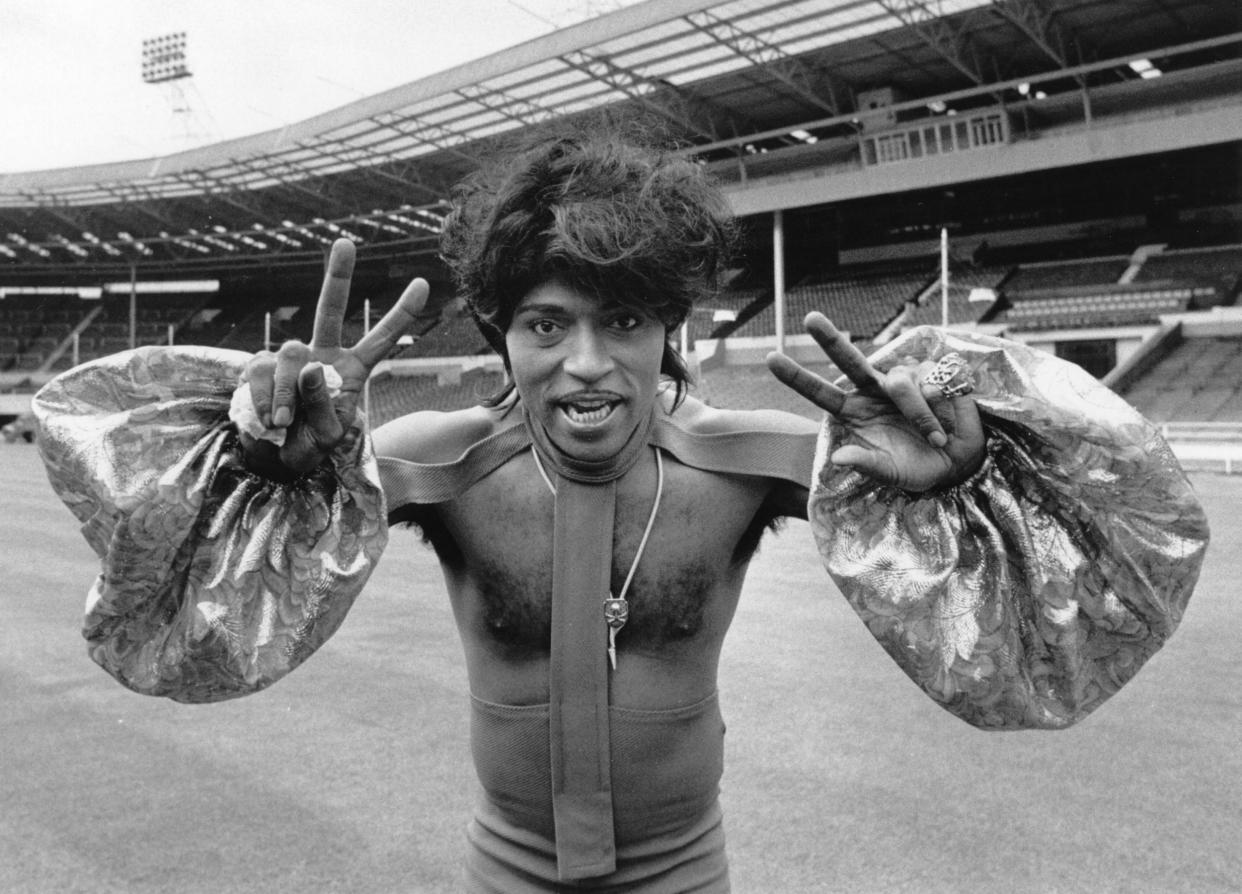‘A wop bop alu-bop, a wop-bam-boom!’ Little Richard, the man who ignited the fires of rock’n’roll

For over 60 years, the jury has been out on the precise point where boogie woogie and rhythm and blues tipped the cultural radio dial into the red, and rock’n’roll was born. Forties blues, skiffle and jazz singles by Sister Rosetta Tharpe, Arthur Crudup, Fats Domino and Jimmy Preston laid a formative bedrock. Chuck Berry’s spotlighting of the electric guitar lit the long fuse. Bill Haley’s “Rock Around The Clock” politely popularised the term.
But in terms of encapsulating its exuberance and attitude, of energising millions of repressed “teenage” rebels and inspiring an aisle-invading abandon, you might point to the moment Little Richard briefly stopped attacking his piano during 1955’s “Tutti Frutti” to vocalise the explosive backbeat pulsing through this new music: “A wop bop alu-bop, a wop-bam-boom!”
The key word is “attack” – where Haley and Berry delivered their rock’n’roll landmarks with the amenability of big band and jump blues, respectively, Little Richard pummelled his instrument and tore at his songs like a southern Pentecostal beast unleashed. It was his unbridled, anarchic energy that Jerry Lee Lewis would channel with every torched piano, Elvis would inject into his raunchiest hip-swivels, and The Beatles would emulate eight hours a night in the dive clubs of Hamburg. John Lennon was reportedly left speechless by “Long Tall Sally”, and when The Beatles supported Richard in 1962, he even took the time to help Paul McCartney perfect his trademark “woooo!”.
“He drove the whole house into a complete frenzy,” Mick Jagger would say of seeing him perform. “I couldn’t believe the power of Little Richard on stage.”
If the sounds of rock’n’roll had been brewing for a decade or more, it was Little Richard, and “Tutti Frutti” in particular, that crystallised it in a moment of blinding cultural fission. A generation ignited at his pounding fingertips. “Boom,” indeed.
It wasn’t just his bristling energy that made Little Richard one of the architects of rock’n’roll, and by extension most popular music today – he also personified its mutinous outsider appeal, and its fundamental immersion in the beat. Here was the effeminate, cross-dressing and sexually explorative cast-out from a deeply religious Georgian family, the loudest kid in the Baptist church singalongs (they nicknamed him “war hawk” for all his screeching), who would hammer out music with tin cans and pots on his front doorstep.
He got his first break aged 14, when he was heard singing Sister Rosetta tunes outside her Macon City Auditorium show in 1947, and was invited to open the show. A performer who found his natural persona in a pompadour haircut, exuberant attire, pencil moustache and pancake makeup; who honed his stagecraft playing “devil music” with travelling medicine freak shows, and on the vaudeville, minstrel and army base circuits, often in drag as Princess LaVonne.
By the time he became public property, giving wild performances of “Long Tall Sally”, “Good Golly Miss Molly” and “Rip It Up” in capes and bejewelled suits – amid bombardments of flung undergarments and stage-invading fans – Little Richard was already the blueprint for rock’n’roll’s transgressive permissiveness and taboo-breaking shock value. Free-love psychedelia and the alien androgyny of Ziggy Stardust was long-rooted in Richard’s “omnisexual” attitude: let’s not forget the original lyrics of “Tutti Frutti” read: “Tutti frutti, good booty/ If it don’t fit, don’t force it/ You can grease it, make it easy.” Little Richard’s shows would break social as well as psychological barriers, as blacks and whites left their segregated areas to dance together in the aisles.
Unhindered by the teen idol image of his peers, Richard was free to exert an even wider influence beyond the clean-cut early era of rock’n’roll. His provocative, sexually charged showmanship paved the way not just to Jagger’s strut, but to James Brown’s sex machine soul prowls, Michael Jackson’s lascivious disco pop, and Prince’s groin-centric funk. The likes of Sam Cooke, Otis Redding and Tina Turner aspired to his supernatural soul squeals, Elton John to his crazed piano magic – 1957’s “Lucille” helped introduce the weighty beats that would morph into classic rock, and in the mid-Sixties, Richard acted as mentor to Jimi Hendrix, who briefly joined his Upsetters band in 1964 and would later claim, “I want to do with my guitar what Little Richard does with his voice,” giving Richard a hand in the development of the psychedelic blues strain that would eventually birth Led Zeppelin.
Patti Smith was so “turned on” by Richard’s “physical, anarchistic and spiritual energy” that she created punk. George Harrison nodded at Richard during The Beatles’ Rock and Roll Hall Of Fame induction and declared: “It’s all his fault, really.” And Rolling Stone wasn’t wrong when it tagged Outkast’s “Hey Ya!” as “an indie rock Little Richard”.
Richard would succumb to plenty of the pitfalls and cliches of the rock’n’roll journey – drugs, religion, wilderness periods and revivalist comebacks – but his impact, and confidence, never waned. “I think my legacy should be that when I started in show business there wasn’t no such thing as rock’n’roll,” the self-styled “innovator, originator and architect” said when announcing his retirement from live performance in 2013. “When I started with ‘Tutti Frutti’, that’s when rock really started rocking.”
Half a century on, Little Richard’s wop-bam-boom is still reverberating.

 Yahoo News
Yahoo News 
